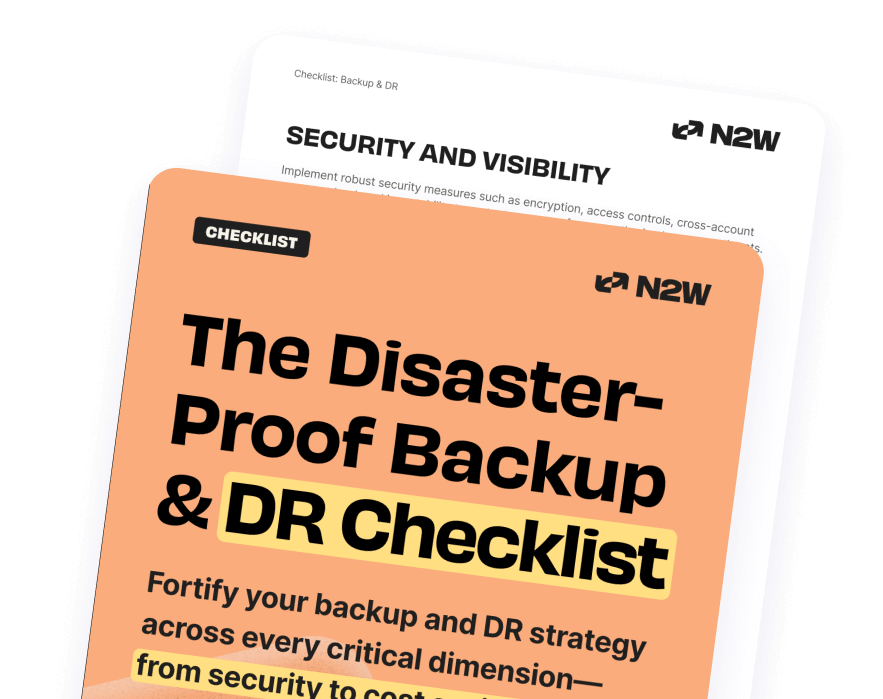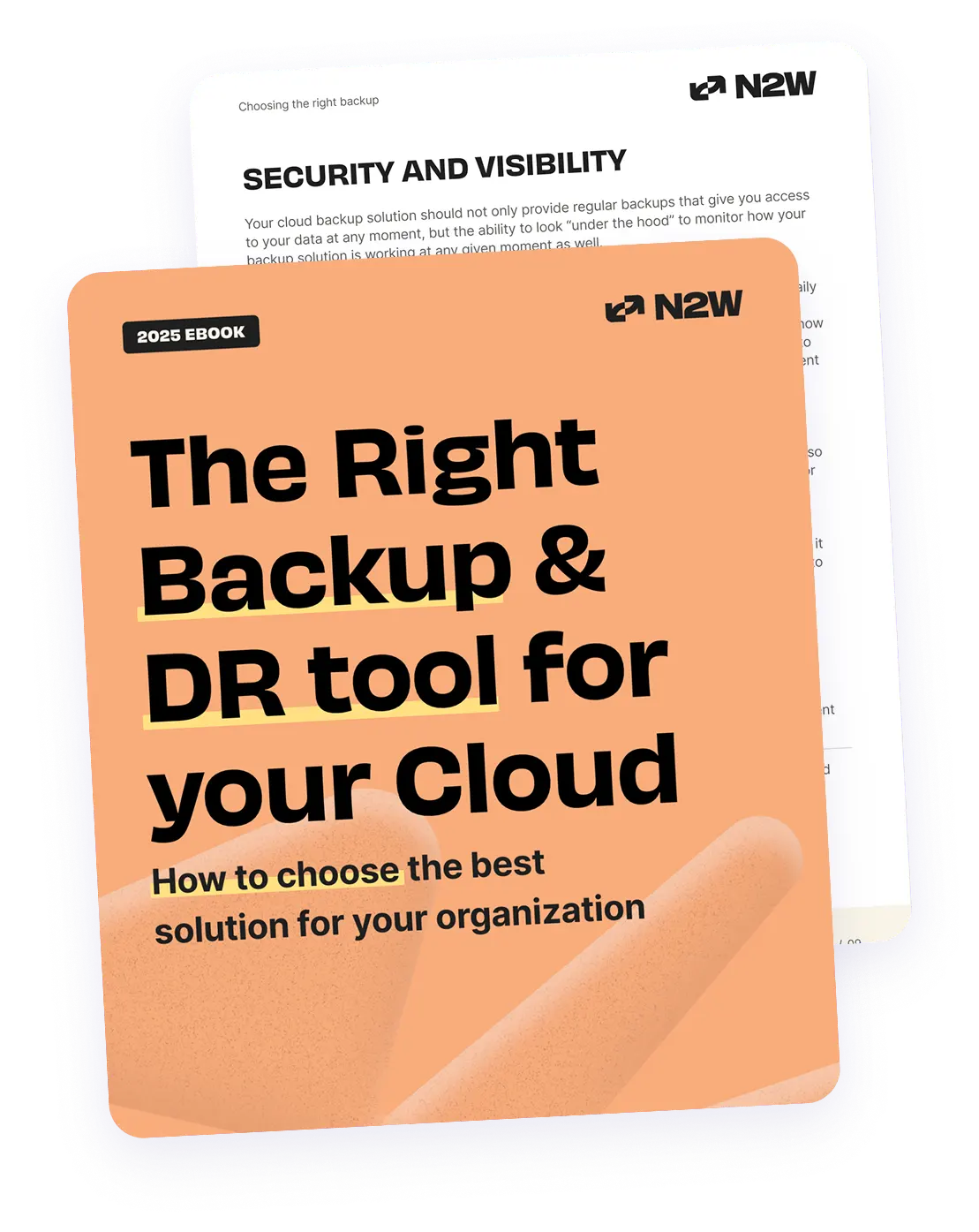N2WS / AWS Backup / A Beginner’s Guide to AWS Backup and Recovery
Cloud computing has revolutionized how we store, access, and manage data. No longer confined to physical servers or limited storage capacities, cloud computing offers scalability, flexibility, and accessibility that traditional methods cannot match. Amazon Web Services (AWS) stands out as a leader among the giants in this domain.
AWS’s prominence in the cloud industry is not just due to its comprehensive service offerings but also because of its reliability, security, and user-friendly nature. However, navigating the AWS ecosystem can be daunting for beginners, especially with critical tasks like data backup and recovery. Missteps in this area can lead to data loss, security vulnerabilities, and significant downtime.
Understanding AWS Backup and Recovery
At its core, AWS backup and recovery is about creating duplicates of data and systems, storing them securely, and restoring them swiftly and efficiently in case of data loss, corruption, or a disaster scenario. This process is crucial in maintaining business continuity and data integrity.
What is AWS backup and recovery?
AWS backup and recovery refers to a set of strategies and services provided by Amazon Web Services, or third party tools, to ensure that data stored on its cloud platform is regularly backed up and can be recovered quickly if needed. This involves copying data and ensuring that the backups are complete, secure, and easily accessible when needed. AWS backup and recovery services cater to various data types and sources, including databases, virtual machines, and file systems.
Key Components and Services in AWS for Backup and Recovery
- AWS Backup: This is a fully managed backup service that simplifies the process of backup and recovery. It offers centralized backup across AWS services and allows you to automate backup schedules, set retention policies, and monitor backup activities.
- Amazon S3 (Simple Storage Service): Known for its high scalability, data availability, security, and performance, Amazon S3 is an object storage service that can store and protect data for various use cases. It is often used as a target backup storage due to its robustness and durability.
- Amazon Glacier: Designed for long-term data archiving, Amazon Glacier provides extremely low-cost storage with reliable durability. It’s an ideal solution for data that is not accessed frequently but needs to be retained for extended periods, like regulatory archives or historical data.
- Amazon EBS (Elastic Block Store): EBS provides block-level storage volumes for EC2 instances. EBS snapshots are a popular method for backing up data stored in EBS volumes.
- AWS Snapshot: This service allows you to take incremental data backups, which means after the initial full backup, only the changes made to the data are backed up. This method is efficient in terms of storage and time.
Redundancy and Data Replication for Data Safety
Data replication and redundancy are fundamental concepts in AWS backup and recovery. Redundancy refers to storing multiple copies of data in different physical locations. This method ensures that if one copy is lost or corrupted, other copies remain intact and accessible. AWS achieves redundancy by storing data across multiple geographically dispersed data centers.
Data replication, however, involves continuously copying data to ensure it is up-to-date and quickly recoverable. In AWS, replication can be done across different regions (cross-region replication) or within the same region (in-region replication), providing an additional layer of data protection.
Fortify your cloud across every critical dimension.
- Efficiency + Optimization
- Security + Control
- Orchestration + Visibility

Best Practices for AWS Backup and Recovery
Navigating the AWS backup and recovery landscape requires an understanding of the tools and services available and a mastery of specific best practices. These practices are crucial in ensuring that your backup and recovery processes are functional, efficient, cost-effective, and aligned with your business needs.
Creating Backup Schedules and Retention Policies
- Regular and Consistent Scheduling: Consistency is key in backup schedules. Determine the frequency of your backups based on the criticality and dynamism of your data. For highly dynamic data, consider daily or even hourly backups. For less critical data, weekly or monthly backups might suffice.
- Automate the Backup Process: You can use a tool like N2WS Backup & Recovery to automate backups. Automation ensures backups occur as scheduled, reducing the risk of human error and saving valuable time and resources.
- Retention Policy Design: Design retention policies that align with your business and compliance requirements. With a tool like N2WS Backup & Recovery, you can define how long each backup is kept. It’s essential to retain backups long enough to meet regulatory requirements and business needs but not so long that they become unmanageable and costly.
- Lifecycle Management: Implement lifecycle policies to transition backups to more cost-effective storage classes. For instance, move older backups to Amazon Glacier for long-term storage at a lower cost. TIP: You can’t do this with AWS Backup, but you can easily automate snapshot archival with N2WS.
Regularly Testing Recovery Procedures
- Frequent Testing: Regularly test your recovery procedures to ensure they work as expected. This testing should be as realistic as possible, potentially involving restoring a backup to a separate environment to verify the integrity and completeness of data.
- Documentation and Training: Maintain comprehensive documentation of recovery processes and ensure that your team is trained and familiar with them. In a crisis, this will expedite recovery and reduce downtime.
- Review and Update Recovery Plans: As your IT environment evolves, so should your recovery plans. Regularly review and update these plans to reflect changes in your AWS usage, infrastructure, and business requirements.
Optimizing Backup Costs and Performance
- Right-Sizing Resources: Evaluate and right-size your AWS resources. Over-provisioning leads to unnecessary costs while under-provisioning can result in poor performance and potential data loss.
- Data Deduplication and Compression: Implement data deduplication and compression to reduce the size of backups, consequently lowering storage costs and improving backup and recovery times.
- Intelligent Tiering: Utilize AWS’s storage tiering options. For example, store recent backups on Amazon S3 for quick access and older backups in Amazon Glacier for cost savings. (Note: you can’t actually archive most snapshots to Glacier using AWS Backup, so you’ll need another tool.)
- Monitoring and Analytics: Regularly monitor your backup and recovery operations using AWS monitoring tools. This will help identify inefficiencies, unnecessary costs, and opportunities for optimization. (HINT: N2WS makes it easy to monitor with built-in Cost Explorer and alerting.)
- Cost Allocation Tags: Use AWS cost allocation tags to track backup costs by department, project, or any other metric relevant to your organization. This helps in understanding and managing costs more effectively. N2WS makes custom tags extremely easy!
Limitations of AWS Backup
AWS Backup serves as a valuable tool for automating and managing backups of AWS resources. However, it’s essential for users to be aware of certain limitations associated with the service.
AWS Backup boasts support for a wide array of AWS-native services, but users should note that third-party application coverage is limited, and not all applications may be included. Also, it’s a given that any workloads you have in another cloud provider, like Azure, won’t be covered by AWS Backup, since they don’t acknowledge the existence of other clouds.
Other limitations include:
- Granularity of Backup Schedules: Users may find limitations in terms of granularity when scheduling backups with AWS Backup. Depending on the resource type, you might not have the flexibility to set a specific backup time.
- Recovery Time Objectives (RTO) and Recovery Point Objectives (RPO): AWS Backup may not meet the low RTO/RPO requirements for certain mission-critical workloads. The speed of recovery and the amount of data loss in case of a restore can vary based on the specific service being backed up.
- Limited Support for Certain Resource Types: While AWS Backup supports a wide range of AWS services, some resource types might have limited or no support. And integration with some AWS services may not be as seamless or feature-rich as users might expect. For example, you can’t actually archive snapshots to S3/Glacier with AWS Backup.
- VPC Configuration Backup and Restore: While AWS Backup can help with the backup and recovery of certain resources, it doesn’t cover the complete backup and restore of VPC configurations, including all networking settings and security groups.
- Cross-Region and Cross-Account Backups: AWS Backup has limitations regarding cross-region and cross-account backups. Depending on the specific requirements, additional configuration or manual processes may be needed.
- Single Pane of Glass: AWS Backup doesn’t offer a centralized dashboard to manage backup, recovery, and data lifecycle management for multiple accounts from one “single pane of glass.” Before you manage resources across multiple AWS accounts in AWS Backup, your accounts must belong to the same organization within the AWS Organizations service.
- Customization and Scripting: While AWS Backup offers a certain level of automation, users with highly complex backup and recovery requirements might find limitations in terms of scripting and customization.
- Disaster Recovery Drills / Recovery Scenarios: AWS Backup does not currently support an easy, script-free (and cost-free) method of running DR Drills or of setting up Recovery Scenarios. Recovery Scenarios by N2WS, for example, allows you to define various sequences of recovery for your backup targets during a recovery session.
As organizations evolve, it’s crucial to stay informed about AWS Backup’s features and limitations. Always refer to the latest AWS backup documentation for the most accurate and up-to-date information to make informed decisions about your backup and recovery strategies.
Why Choose N2WS for AWS Backup and Recovery?
In cloud data protection, especially within the AWS ecosystem, N2WS has emerged as a premier solution, providing a robust, efficient, and user-friendly tool for backup and recovery. Choosing N2WS for your AWS backup and recovery needs offers several distinct advantages that cater to a wide range of organizations, from small businesses to large enterprises.
Enhanced Data Protection Capabilities
- Comprehensive Coverage: N2WS offers extensive coverage across various AWS services. This ensures that all your critical data across various AWS resources, like EC2, RDS, and SAP HANA, are well protected.
- High-Level Customization: Unlike some other backup and recovery solutions, N2WS provides a high degree of personalization. This allows you to tailor your backup and recovery strategies to fit business needs and regulatory requirements.
- Advanced Disaster Recovery Options: With N2WS, you can implement sophisticated disaster recovery strategies. This includes cross-region and cross-account backups, essential for maintaining data integrity and availability in the face of regional AWS outages.
Optimized for Cost and Performance
- Cost-Effective Storage Management: By efficiently managing the lifecycle of backups and integrating with cheaper storage options like Amazon Glacier, N2WS ensures cost-effective backup and recovery, helping you save up to 98% on storage costs.
- Resource Optimization: N2WS allows for precise control over your backup resources, helping you avoid unnecessary costs with tools like Resource Control.
User-Friendly and Flexible
- Ease of Use: N2WS boasts a user-friendly interface, making it simple for beginners to navigate while offering the advanced features experienced IT professionals require.
- Flexible Backup Policies and Schedules: You have the flexibility to create and manage backup policies and schedules that align with your operational requirements, all from a single dashboard.
Enhanced Security and Compliance
- Robust Security Features: N2WS incorporates full security features to protect your data. This includes encryption of backups, both in transit and at rest, ensuring that sensitive data is always secure.
- Compliance Ready: N2WS helps organizations meet various compliance standards, such as GDPR and HIPAA. This is crucial for organizations that operate under strict regulatory requirements, like financial institutions and government agencies.
Superior Support and Community
- Dedicated Customer Support: N2WS provides exceptional customer support, with a team of experts ready to assist with any issues or questions, guaranteeing minimal downtime and quick resolution of problems.
- Documentation and Resources: Benefit from a wealth of resources, including detailed documentation, best practices guides, and easy-to-follow videos.
Continuous Innovation and Integration
- Regular Updates and New Features: N2WS is committed to continuous improvement, regularly updating its service offerings with new features and capabilities that keep pace with innovations.
- Seamless Integration with AWS Services: As an AWS-native solution, N2WS seamlessly integrates with AWS services, ensuring a smooth, efficient backup and recovery process.
Get started with N2WS Backup & Recovery for AWS
For a limited time, when you activate a free trial of N2WS Backup & Recovery, you can get $100 in AWS Infrastructure Credits —so your POC is absolutely free!
👉 Get N2WS from the AWS Marketplace

Ezra is the Sr. Director of Alliances and Partners at N2WS with more than 10 years of experience. Ezra enjoys long bike rides, cultivating rare semi-succulents, and building complex aquatic ecosystems.
